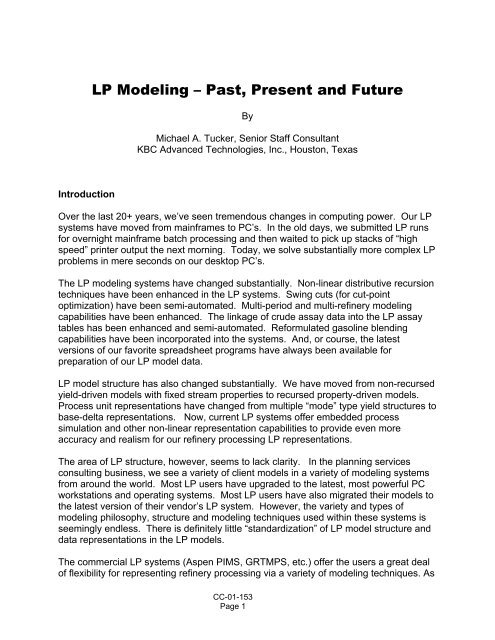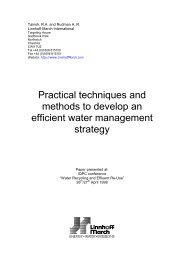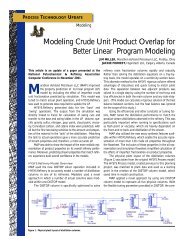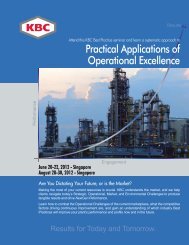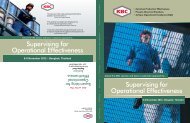LP Modeling - Past, Present and Future
LP Modeling - Past, Present and Future
LP Modeling - Past, Present and Future
You also want an ePaper? Increase the reach of your titles
YUMPU automatically turns print PDFs into web optimized ePapers that Google loves.
Introduction<br />
<strong>LP</strong> <strong>Modeling</strong> – <strong>Past</strong>, <strong>Present</strong> <strong>and</strong> <strong>Future</strong><br />
By<br />
Michael A. Tucker, Senior Staff Consultant<br />
KBC Advanced Technologies, Inc., Houston, Texas<br />
Over the last 20+ years, we’ve seen tremendous changes in computing power. Our <strong>LP</strong><br />
systems have moved from mainframes to PC’s. In the old days, we submitted <strong>LP</strong> runs<br />
for overnight mainframe batch processing <strong>and</strong> then waited to pick up stacks of “high<br />
speed” printer output the next morning. Today, we solve substantially more complex <strong>LP</strong><br />
problems in mere seconds on our desktop PC’s.<br />
The <strong>LP</strong> modeling systems have changed substantially. Non-linear distributive recursion<br />
techniques have been enhanced in the <strong>LP</strong> systems. Swing cuts (for cut-point<br />
optimization) have been semi-automated. Multi-period <strong>and</strong> multi-refinery modeling<br />
capabilities have been enhanced. The linkage of crude assay data into the <strong>LP</strong> assay<br />
tables has been enhanced <strong>and</strong> semi-automated. Reformulated gasoline blending<br />
capabilities have been incorporated into the systems. And, or course, the latest<br />
versions of our favorite spreadsheet programs have always been available for<br />
preparation of our <strong>LP</strong> model data.<br />
<strong>LP</strong> model structure has also changed substantially. We have moved from non-recursed<br />
yield-driven models with fixed stream properties to recursed property-driven models.<br />
Process unit representations have changed from multiple “mode” type yield structures to<br />
base-delta representations. Now, current <strong>LP</strong> systems offer embedded process<br />
simulation <strong>and</strong> other non-linear representation capabilities to provide even more<br />
accuracy <strong>and</strong> realism for our refinery processing <strong>LP</strong> representations.<br />
The area of <strong>LP</strong> structure, however, seems to lack clarity. In the planning services<br />
consulting business, we see a variety of client models in a variety of modeling systems<br />
from around the world. Most <strong>LP</strong> users have upgraded to the latest, most powerful PC<br />
workstations <strong>and</strong> operating systems. Most <strong>LP</strong> users have also migrated their models to<br />
the latest version of their vendor’s <strong>LP</strong> system. However, the variety <strong>and</strong> types of<br />
modeling philosophy, structure <strong>and</strong> modeling techniques used within these systems is<br />
seemingly endless. There is definitely little “st<strong>and</strong>ardization” of <strong>LP</strong> model structure <strong>and</strong><br />
data representations in the <strong>LP</strong> models.<br />
The commercial <strong>LP</strong> systems (Aspen PIMS, GRTMPS, etc.) offer the users a great deal<br />
of flexibility for representing refinery processing via a variety of modeling techniques. As<br />
CC-01-153<br />
Page 1
a result, individual refinery <strong>LP</strong> model developers have used a variety of methods <strong>and</strong><br />
structure to represent their process unit submodels including: Multiple modes, basedelta<br />
modeling, embedded simulation, pooling <strong>and</strong> distributive recursion. All of these<br />
techniques have been applied to varying degrees in various models.<br />
So, the question is: What’s is the best <strong>LP</strong> modeling method? Why?<br />
In this paper, we discuss the trends <strong>and</strong> industry practices in <strong>LP</strong> refinery modeling.<br />
What has changed in <strong>LP</strong> modeling <strong>and</strong> why has it changed? What are the common<br />
modeling techniques, structure <strong>and</strong> data generating techniques that are being used<br />
today? Where are we headed with modeling structure?<br />
Hopefully, this paper will stimulate thinking about your refinery <strong>LP</strong> model. How does<br />
your model structure <strong>and</strong> data compare with industry best practices? Should you<br />
consider upgrading your <strong>LP</strong> model? What are the possible benefits? What are the<br />
risks?<br />
The goal is clear – what refiners want <strong>and</strong> need are <strong>LP</strong> planning models that accurately<br />
represent the true capabilities <strong>and</strong> limitations of their refining facilities. We want the <strong>LP</strong><br />
model to give us sound advise about crude selection, process optimization, oil<br />
movements, product blending <strong>and</strong> product optimization.<br />
What isn’t always clear is what are the best modeling technologies <strong>and</strong> techniques to<br />
achieve superior accuracy from the model? Also, what is the appropriate degree of<br />
accuracy considering the trade-offs between the desire for simplicity, ease of use, <strong>and</strong><br />
the drive for accuracy?<br />
<strong>Past</strong> <strong>LP</strong> <strong>Modeling</strong><br />
Going back a number of years (15 to 20), we had what I’ll call the Pre-Recursion type<br />
models. These models had no stream pooling <strong>and</strong> no recursion. The crude unit models<br />
were presented by a series of yield structures for each crude. The characteristics were:<br />
• Each cutting scheme (max naphtha, max kerosene, etc.) had a separate yield<br />
structure (mode) for each crude.<br />
• The major side-cuts from each crude (<strong>and</strong> from certain cuts from each cutting<br />
scheme) were unique streams, with unique names <strong>and</strong> unique (fixed) qualities.<br />
• Generally, the crude assay table data was generated by a crude assay system<br />
(containing a library of crude oils). Yields <strong>and</strong> properties from the assay system<br />
were generally those predicted from laboratory TBP distillations. In many cases,<br />
the systems were automated to generate the <strong>LP</strong> crude assay tables in the <strong>LP</strong><br />
assay table format.<br />
CC-01-153<br />
Page 2
The downstream process unit sub-models were also represented by a series of multiple<br />
yield structures. The characteristics of the process unit sub-models were:<br />
• Each feed to a downstream process unit was from a side-cut from a particular<br />
crude.<br />
• Each process unit feed has one or more yield structures (modes) representing<br />
the processing of each unique feed under specific operating conditions e.g. a<br />
particular reactor temperature.<br />
• The products from each mode had fixed qualities. Frequently, each feed/mode<br />
combination would produce streams with different fixed qualities.<br />
• The yields were typically generated using simulation models. Each side-cut from<br />
each crude was processed through the simulator at a particular operating<br />
conditions (e.g. severity) to produce a unique set of yields <strong>and</strong> product properties<br />
for the feedstock. In many cases, the simulators were automated to generate<br />
the necessary yield structures for the <strong>LP</strong> model.<br />
In our efforts to further differentiate one crude from another, we frequently generated<br />
literally hundreds of yield structures for process unit sub-model to represent each<br />
possible crude side-cut at multiple operating conditions <strong>and</strong> multiple cutting schemes.<br />
Frequently, the process unit might be structured to produce anywhere from 4 to 20+<br />
versions of each product stream (each with unique qualities associated with a particular<br />
crude <strong>and</strong>/or cutting scheme).<br />
Models of this type tended to have the following overall characteristics:<br />
• There were generally 3 to 10 times as many individual streams in the model as<br />
there were streams in the “real” refinery.<br />
• There were generally 10 to 20 times as many final product blending options as<br />
there were actual component blending options available in the “real” refinery.<br />
Distributive Recursion Technique<br />
During a Chevron <strong>LP</strong> training class at El Segundo, California in 1977, Bill Hart, a senior<br />
mathematician from Haverly Systems, was working with Don White, a senior <strong>LP</strong><br />
modeler from Chevron. Don’s complaint was that these types of multiple yield <strong>and</strong><br />
mode type <strong>LP</strong> models tended to over-optimize the processing <strong>and</strong> blending of individual<br />
crude <strong>and</strong> their associated side-cuts throughout the refinery. The model frequently<br />
overstated the value difference between individual crudes. Don wanted a better way.<br />
During that class, Bill Hart developed the mathematics for the recursion technique that<br />
became known as Distributive Recursion (DR). Up to that time, some attempts had<br />
been made to use a simple recursion technique. The Distributive Recursion technique<br />
CC-01-153<br />
Page 3
added the critical linkage between upstream changes in pool qualities to the quality<br />
changes in the downstream destinations. Early versions of the DR technique were<br />
slow <strong>and</strong> difficult to work with. Over the years since then, the technique has become<br />
faster, better, <strong>and</strong> more reliable. The technique is increasingly popular <strong>and</strong> is now<br />
widely accepted in the <strong>LP</strong> modeling systems <strong>and</strong> refinery models.<br />
Current <strong>LP</strong> <strong>Modeling</strong> Practices<br />
As mentioned earlier, there is an infinite variety of modeling techniques currently being<br />
used. However, we can, at least, categorize <strong>and</strong> discuss current modeling practices in<br />
the various areas of the <strong>LP</strong> model structure.<br />
Crude Distillation Swing Cuts<br />
Swing cuts are increasing used in <strong>LP</strong> assay tables to represent the refinery’s flexibility<br />
to alter cut-points for optimization of side-cut yields <strong>and</strong> properties. When used, swing<br />
cuts have generally replaced the older multiple “mode” type of yields structures. The<br />
Aspen PIMS system, for instance, has provided a Type 4 swing cut in their CRDCUTS<br />
table. The system will then automatically generate the necessary structure for blending<br />
the swing cut up <strong>and</strong> down. Swing cuts are frequently used for Naphtha/Kerosene,<br />
Kerosene/Diesel cuts <strong>and</strong> for Gasoil/Bottoms cuts as well as others. A majority of <strong>LP</strong><br />
models now employ swing cut architecture in at least some of the crude distillation side-<br />
cuts. In general, the swing cuts are also used along with side-cut property recursion<br />
techniques such that main side-cut yields <strong>and</strong> properties are impacted by the swing cut<br />
blending.<br />
Crude Assay Recursed Properties<br />
Most crude assay tables now include recursed properties for the various side-cuts.<br />
Typically, the side-cuts in the model now match the physical side-cuts from the “real”<br />
refinery, with the exception of the swing cuts. The individual side-cuts generally have<br />
anywhere from 3 or 4 recursed properties to over 20. The average number of recursed<br />
properties in most models is about 7 to 10. The side-cut recursed properties are not<br />
just used for product blending. The properties are now frequently used as product yield<br />
<strong>and</strong> property drivers in downstream process units sub-models (e.g. % Naphthenes <strong>and</strong><br />
% Aromatics for Reformer sub-models).<br />
Commercial Distillation Properties<br />
<strong>LP</strong> crude assay data is frequently generated by using one or more of the vendor crude<br />
assay libraries in conjunction with a commercial crude assay system. The assay data<br />
from these libraries is based on laboratory distillation results. In the past, most <strong>LP</strong>’s<br />
included these laboratory predicted properties, rather than commercial unit properties.<br />
Increasingly, <strong>LP</strong> modelers are interested in getting the commercial unit distillation<br />
results into the <strong>LP</strong>. Right now, there are three main techniques that are in common use:<br />
CC-01-153<br />
Page 4
1. Some modelers “offset” the laboratory properties in the <strong>LP</strong> model to more<br />
accurately match the commercial results. This works reasonably well in those<br />
situations where the crude slate is relatively stable.<br />
2. In recent years, the vendor assay systems have added features designed to<br />
allow a degree of side-cut overlap with associated property predictions. The<br />
systems require the user to supply the parameters for the column tuning. These<br />
parameters have been used with varying degrees of success.<br />
3. Those refiners who maintain a tuned column simulation model (e.g. KBC<br />
Petrofine DISTOP) generally use this column simulation along with an assay<br />
library <strong>and</strong> system to generate the yields <strong>and</strong> properties for the <strong>LP</strong> assay table.<br />
With this system, each of the library crudes is processed through the column<br />
simulation to then predict the yields <strong>and</strong> properties for the side-cuts based on<br />
the tuned column simulator. Multiple runs of the simulator are required to backcalculate<br />
the properties of the swing cuts used in the <strong>LP</strong> model. Systems are<br />
now becoming available to automate the multiple simulator runs <strong>and</strong> the back<br />
calculation processes.<br />
In recent years, the <strong>LP</strong> systems have added the capability to use multiple assay tables.<br />
Hence, it is now convenient to provide customized <strong>and</strong> tuned yields <strong>and</strong> properties for<br />
each of the refinery’s physical <strong>and</strong>/or logical distillation column operations.<br />
Base-Delta Process Unit Sub-Models<br />
Concurrent with the development <strong>and</strong> implementation of DR is the use of base-delta<br />
modeling techniques for major process unit sub-models. The base-delta modeling<br />
technique has the following characteristics:<br />
1. A single base yield structure provides the yields <strong>and</strong> product properties<br />
associated with a typical quality feed at normal operation conditions. This yield<br />
structure is customized <strong>and</strong> tuned to the particular refinery process unit. In some<br />
variations of this technique, multiple base yields are provided at alternative<br />
severities of operation. In most cases, the base yield structure is generated<br />
from a single run of a tuned simulator for the particular process unit.<br />
2. Feed property drivers are used to provide shifts (or correctors) for changes in<br />
feed properties relative to the base feed quality. These shift correctors represent<br />
the linear change in yields (<strong>and</strong> product properties) as a function of changes in<br />
feed properties. These shift correctors are generally calculated by the use of the<br />
process simulators. DR techniques are used to provide the necessary feed<br />
properties from the various upstream sources <strong>and</strong> feed pools.<br />
There are two common techniques used to generate these correctors:<br />
CC-01-153<br />
Page 5
a. The perturbation technique changes each feed property independently (up<br />
<strong>and</strong> down) <strong>and</strong> then calculates the linear shift from the perturbation cases.<br />
b. A multi-variable linear regression technique is used to calculate the linear<br />
shift correctors based on the regressed results for product yields <strong>and</strong><br />
properties from a large number of feed property scenarios when run<br />
through the simulator.<br />
3. Operating variable drivers are provided to shift yields (<strong>and</strong> product properties) off<br />
the base for changes in operating conditions (typically severity). Again, the<br />
process simulators are generally used to generate the delta shifts for these<br />
operating conditions.<br />
4. DR techniques are frequently used to recurse on key product properties. The<br />
base, feed property drivers, <strong>and</strong> operating variable shifts all contain coefficients<br />
that calculate the appropriate recursed product properties. Process unit product<br />
stream properties are either variable (recursed) or fixed. In general, if the<br />
product property remains relatively constant regardless of the feed <strong>and</strong>/or<br />
operating shifts, then the property may be fixed. Otherwise, the property should<br />
be recursed. The use of product stream recursion has eliminated the need for<br />
multiple versions of the same stream (as used in pre-recursion models). Now,<br />
the streams in the <strong>LP</strong> model (represented by pools with recursed properties)<br />
more closely match the streams in the “real” refinery.<br />
5. Many of the major process unit sub-models now use swing cuts for key cutpoint<br />
optimization representations. Multiple runs of the process simulators are<br />
generally used to back-calculate the yields <strong>and</strong> properties for the swing cuts used<br />
in the process sub-models.<br />
6. Most base-delta models now use multiple capacity constraints. Many of the older<br />
models simply had one (maximum throughput) constraint. With base-delta<br />
models using severity shifts, it is now appropriate to include several other<br />
capacity constraints associated with operating constraints <strong>and</strong> variables e.g.<br />
maximum air blower limits on an FCC unit or main fractionator side-cut draw<br />
limits.<br />
Local Optimal Problems<br />
Most of the current <strong>LP</strong> models have some degree of pooling <strong>and</strong> property recursion.<br />
The DR technique requires initial guesses for pool qualities <strong>and</strong> fractional distributions<br />
of the pools to downstream destinations. As with any non-linear technique, there will be<br />
a risk of local optimal solutions i.e. a solution that does not represent the highest<br />
possible objective function. In all local optimal cases, the initial guesses <strong>and</strong> the<br />
subsequent recursion calculations lead to a solution that is not the global optimum.<br />
CC-01-153<br />
Page 6
For models that contain a moderate (or higher) degree of recursion, there are only two<br />
situations:<br />
1. The model users have experienced local optimal problems <strong>and</strong> they know they<br />
exist.<br />
2. The model users don’t know they have local optimal problems (however, they do<br />
exist but they have not yet been discovered by accident or testing).<br />
We’ve found that almost every model that contains a moderate (or higher) level of<br />
recursion experiences local optimal problems (some more than others). This is a<br />
serious problem that can lead to a lack of confidence in the model results. Local<br />
optimal problems in recursed <strong>LP</strong>’s cannot be completely eliminated but they can be<br />
managed. It takes a combination of:<br />
1. Good model structure that avoids unnecessary recursion <strong>and</strong> things like<br />
cascading recursed pools <strong>and</strong> large numbers of downstream destinations for<br />
recursed pools.<br />
2. Attention to correctly setting the initial guesses <strong>and</strong> the recursion control<br />
parameters. The system default recursion control parameters are not always the<br />
best settings.<br />
3. Testing for local optimal conditions <strong>and</strong> then analyzing <strong>and</strong> underst<strong>and</strong>ing the<br />
conditions under which they occur <strong>and</strong> correcting those conditions.<br />
Blending<br />
In the blending area, current <strong>LP</strong> models contain significantly more property<br />
specifications than in the past. The sophistication required for the blending equations is<br />
increasing – as evidenced by reformulated gasoline. Increasingly, the blend<br />
components in the model are nearly the same as those that exist in the “real” refinery<br />
(via recursed pools) <strong>and</strong> the component properties are frequently linked all the way<br />
back (via distributive recursion) to the properties of the side-cuts in the crude assay<br />
tables.<br />
Multi-Refinery <strong>and</strong> Multi-Period <strong>Modeling</strong><br />
There is an increasing use of multi-period <strong>and</strong> multi-refinery modeling by the user<br />
community. Mainly, this trend is the result of faster computers <strong>and</strong> enhanced features in<br />
the <strong>LP</strong> modeling systems for h<strong>and</strong>ling the parameters <strong>and</strong> input associated with multiperiod<br />
<strong>and</strong> multi-refinery. (It’s also the results of all of those mergers <strong>and</strong> acquisitions in<br />
the industry).<br />
There is one caution, however, in that recursed models tend to be unstable (i.e. local<br />
optimal <strong>and</strong>/or non-converged) when attempting to use both multi-period <strong>and</strong> multi-<br />
CC-01-153<br />
Page 7
efinery in the same case. Also, there are limitations on the use of multi-refinery. In<br />
general, no more than about 3 refineries should be attempted with recursed <strong>LP</strong> multirefinery<br />
models. Large recursed multi-refinery models tend to be unstable as<br />
represented in the following graph.<br />
Recursed Pools<br />
600<br />
500<br />
400<br />
300<br />
200<br />
100<br />
1000 3000 5000 7000 9000<br />
Model Maintenance<br />
1<br />
2<br />
Stable<br />
Matrix Rows<br />
3 Refineries<br />
Unstable<br />
This paper is mainly about <strong>LP</strong> model structure. However, there are some important<br />
points to be made about generating the <strong>LP</strong> data <strong>and</strong> maintaining the <strong>LP</strong> model. In the<br />
past, we occasionally (every few months) compared the actual plant process data with<br />
the <strong>LP</strong> predicted yields. We looked at combinations of test run results, historical<br />
process data, <strong>and</strong> yield accounting data when updating <strong>LP</strong> models <strong>and</strong> sub-models. <strong>LP</strong><br />
sub-models were not frequently updated (maybe once every couple of years) <strong>and</strong> the<br />
methodology for updating the <strong>LP</strong> sub-model was not very well defined.<br />
Currently, there are two main best practice methods for monitoring <strong>LP</strong> performance <strong>and</strong><br />
maintaining <strong>and</strong> updating <strong>LP</strong> models. First, an overall refinery backcasting process may<br />
be used to identify overall model weaknesses (e.g. refinery gain higher than actual) <strong>and</strong><br />
profit opportunities. Backcasting is comparing a previous month’s actual results against<br />
the plan <strong>and</strong> against an <strong>LP</strong>-actual case (where the <strong>LP</strong> case attempts to match actual<br />
results). Many refineries conduct backcasting on a regular basis (at least several times<br />
each year). <strong>LP</strong> maintenance activities are frequently based on the backcast results.<br />
The second major activity is for process engineers to monitor their process units on a<br />
weekly or bi-weekly basis. Lab samples, along with plant historian data are used to<br />
compare the actual process unit results (yields <strong>and</strong> properties) against the <strong>LP</strong> predicted<br />
CC-01-153<br />
Page 8
esults for the same snapshot period. Process engineers <strong>and</strong> planners monitor <strong>and</strong><br />
compare the actual against the <strong>LP</strong> predicted <strong>and</strong> decide if the <strong>LP</strong> sub-model needs<br />
updating. In most cases, a process simulator model may be re-calibrated <strong>and</strong> used to<br />
generate the <strong>LP</strong> base <strong>and</strong> delta correctors on an as-needed basis. With this technique,<br />
process unit sub-models may be updated as frequently as several times a year using<br />
plant data <strong>and</strong> tuned simulator models.<br />
<strong>Future</strong> <strong>LP</strong> Developments<br />
The <strong>LP</strong> system vendors are now touting the virtues of the latest major <strong>LP</strong> system<br />
enhancement: simulator interfaces. With the simulator interface, the <strong>LP</strong> system may be<br />
directed to an outside application during each recursion pass. This outside application<br />
may be as simple as a single non-linear equation or as complex as several large<br />
complex process simulation models.<br />
The concept is that model coefficients that were previously static (i.e. unchanged during<br />
recursion) now become dynamic (changing after each recursion pass). For example,<br />
the feed % naphthene <strong>and</strong> % aromatics linear yield shift correctors commonly used in<br />
reformer <strong>LP</strong> models are generally based on particular feed qualities <strong>and</strong> severities.<br />
These linear correctors are calculated externally during the model development <strong>and</strong><br />
then built into the model. These yield correctors are not updated during recursion. The<br />
<strong>LP</strong> model predicted yields become less accurate if the <strong>LP</strong> optimized feed deviates<br />
significantly from the base feed quality assumptions.<br />
With the simulator interface option, these linear feed property correctors may now be<br />
calculated <strong>and</strong> updated during each recursion pass, <strong>and</strong> then used for the next<br />
optimization pass. As the model optimizes the feed quality <strong>and</strong> severity after each<br />
pass, the naphthene <strong>and</strong> aromatics correctors are then adjusted to match the last pass<br />
results. This improves the accuracy since the final converged solution of the <strong>LP</strong> more<br />
closely matches the results of the simulation prediction.<br />
However, the risk of a local optimal solution may increase, since more <strong>and</strong> more<br />
coefficients are recursed <strong>and</strong> the initial starting assumptions for feed quality <strong>and</strong><br />
severity become increasingly important as they may influence the final converged<br />
solution.<br />
A number of refiners have successfully developed useful <strong>and</strong> reliable applications for<br />
the simulator interface. There are a number a relatively simple non-linear applications<br />
being used where previously unsolvable non-linear relationships have now been<br />
h<strong>and</strong>led with the simulator interface. For instance, in one application, we needed to<br />
control the percent of a particular feed to a process unit. In this particular case, the<br />
percent was an unknown <strong>and</strong> the process unit feedrate was also an unknown. This was<br />
previously unsolvable with DR. However, with the simulator interface, it was now<br />
possible to externally calculate the correct percent (based on the first optimized<br />
solution) <strong>and</strong> then update the percent following each recursion pass.<br />
CC-01-153<br />
Page 9
Larger simulator interface applications have also been tested <strong>and</strong> developed using, for<br />
example, embedded reformer simulator models, FCC simulation models <strong>and</strong>, most<br />
recently, crude unit simulation with cutpoint shifts <strong>and</strong> cutpoint optimization (replacing<br />
swing cuts).<br />
Will this be the future of <strong>LP</strong> models? Perhaps. There are a number of issues to be<br />
solved: slow calculations, local optimal problems, complexity of data input, complexity<br />
of model output, etc. History would suggest that these problems can <strong>and</strong> will be<br />
solved. Also, the general trend over the years has been towards the use of additional<br />
non-linear techniques (mostly recursion) driven by the refiners desire for improved<br />
accuracy. Certainly, the simulator interface is a logical step in that same direction of<br />
improved accuracy.<br />
Conclusion<br />
<strong>LP</strong> systems accommodate a variety of modeling technique, structure <strong>and</strong> philosophies.<br />
Your current <strong>LP</strong> model structure is usually a complex function of the particular refining<br />
configuration, the <strong>LP</strong> system, economic drivers, logistical operational constraints,<br />
process unit simulation model availability, initial <strong>and</strong> legacy model structure, <strong>LP</strong><br />
maintenance, backcasting analysis, <strong>and</strong> past <strong>and</strong> current <strong>LP</strong> modeler knowledge <strong>and</strong><br />
experience.<br />
The industry, in general, is trending towards models that use pooling <strong>and</strong> distributive<br />
recursion techniques to provide more realistic <strong>and</strong> accurate representations of the<br />
refinery in the <strong>LP</strong> system.<br />
What are the benefits of <strong>LP</strong> improvements? This has always been a difficult area to<br />
address. The KOA paper from last year’s conference suggests one method. Intuitively,<br />
most refining companies recognize the value of improved accuracy in their refinery <strong>LP</strong><br />
representations <strong>and</strong> the technology has been moving in that direction over the years.<br />
We see improved <strong>LP</strong> accuracy in two areas: absolute accuracy <strong>and</strong> incremental<br />
accuracy. Improved absolute accuracy is achieved by frequent tuning <strong>and</strong> updating of<br />
the <strong>LP</strong> base yields <strong>and</strong> properties. Improved incremental accuracy is achieved through<br />
superior <strong>LP</strong> modeling structure that provides the correct effects for incremental changes<br />
throughout the refinery – from crude to products. Improvements in both of these areas<br />
may lead to millions of dollars of annual profit improvement resulting from plans <strong>and</strong><br />
operating decisions that better utilize the refining asset.<br />
The following table contains a checklist of best practice <strong>LP</strong> modeling features <strong>and</strong><br />
structure (discussed above) that should be considered <strong>and</strong> evaluated for your particular<br />
modeling circumstances.<br />
CC-01-153<br />
Page 10
Every refinery <strong>LP</strong> model situation is unique. Some of these features may not be best<br />
suited for your particular circumstances. However, in general, if your model structure<br />
lacks these features, you may wish to consider the merits of an <strong>LP</strong> upgrade.<br />
<strong>LP</strong> Model Structure Checklist<br />
Streams in the <strong>LP</strong> model generally match streams that exist in the refinery �<br />
<strong>LP</strong> Model uses pooling with recursion on key properties of the pools �<br />
Crude unit side-cut properties are based on commercial distillation<br />
�<br />
performance on individual crude units. Tuned distillation simulation is used<br />
to generate data for the <strong>LP</strong> assay tables.<br />
Swing cuts are used in crude units <strong>and</strong> downstream process unit <strong>LP</strong> sub- �<br />
models to represent cut-point optimization capabilities<br />
Base-delta <strong>LP</strong> structure for major downstream process unit representations �<br />
Tuned simulators used to generate base <strong>and</strong> delta yield <strong>and</strong> properties for �<br />
major downstream process unit <strong>LP</strong> models<br />
Process unit <strong>LP</strong> models include both key feed property drivers <strong>and</strong> key �<br />
operating variable shifts<br />
Multiple, realistic process unit constraints �<br />
Local optimal risk minimized with appropriate structure <strong>and</strong> recursion �<br />
control settings<br />
Testing for <strong>and</strong> correcting local optimal conditions �<br />
Frequent backcasting for <strong>LP</strong> model audit <strong>and</strong> opportunity evaluation �<br />
Process unit routine monitoring, evaluation <strong>and</strong> <strong>LP</strong> process model updating<br />
based on tuned simulation models<br />
�<br />
About the Author<br />
Michael A. Tucker is a Senior Staff Consultant at KBC Advanced Technologies, Inc.<br />
based in Houston, Texas. Mike is currently responsible for providing Planning Services<br />
to worldwide refinery clients, including the management of <strong>LP</strong> upgrade projects. Mike<br />
has 31 years of oil industry experience working, supporting <strong>and</strong> consulting on <strong>LP</strong><br />
planning for Chevron Corporation, Caltex Petroleum Corporation <strong>and</strong> KBC Advanced<br />
Technologies. Mike holds a B.S. in Chemical Engineering from Purdue University.<br />
Petrofine ® is a registered trademark of KBC Process Technologies, Ltd. Aspen PIMS is a registered<br />
trademark of Aspen Technology. GRTMPS is a registered trademark of Haverly Systems, Inc.<br />
CC-01-153<br />
Page 11


